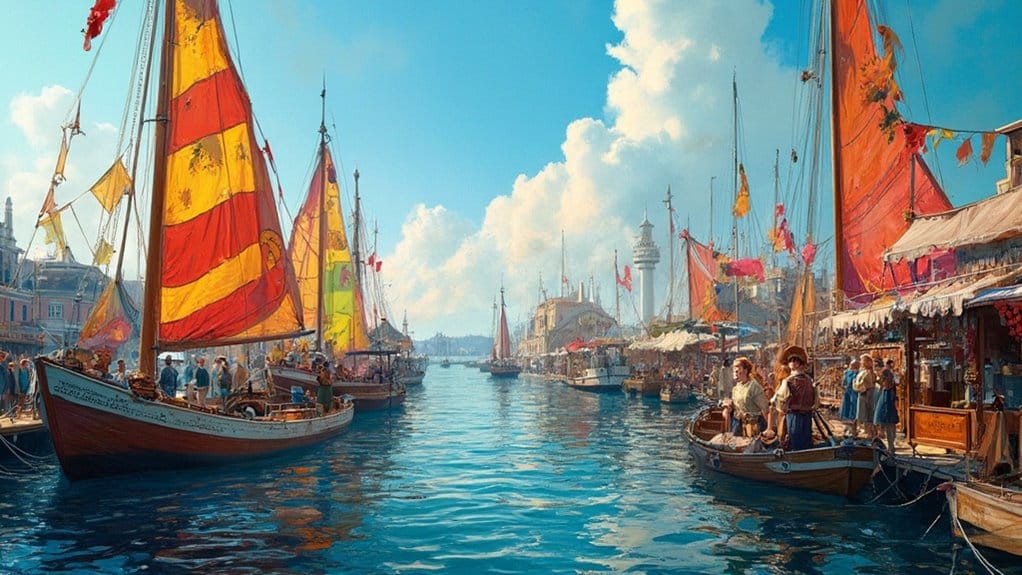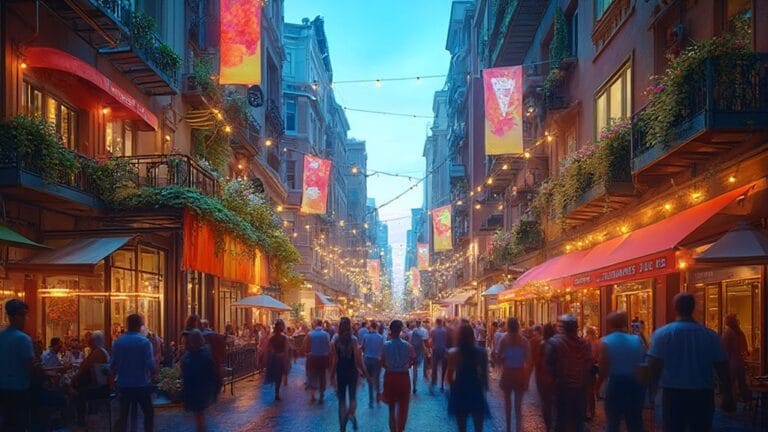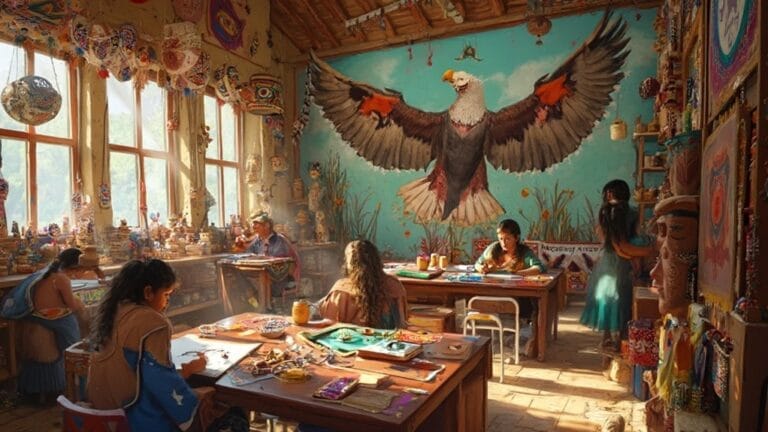Maritime folk festivals are like a warm hug from Canada's East Coast, wrapping you in vibrant music and delicious multicultural food. I remember my first visit to the Pictou Lobster Carnival, where the joyful fiddles danced through the air, connecting generations and traditions. From intimate stages at the Stan Rogers Folk Festival to the lively workshops at Mariposa, there's something for everyone! These gatherings not only showcase local talent but also bring communities together, fostering a spirit of collaboration. Plus, they draw folks from all over, shining a light on Canada's unique culture. Stick around, and you'll see why these festivals are truly special!
Key Takeaways
- Maritime folk festivals showcase diverse musical genres, preserving traditional fiddling styles and regional heritage vital to Canada's cultural identity.
- They foster community engagement, connecting local residents and visitors through shared traditions and volunteer participation.
- Unique formats and immersive experiences enhance attendee enjoyment, promoting cultural exchange through music, crafts, and workshops.
- Festivals contribute significantly to local economies, boosting tourism and creating job opportunities while supporting small businesses.
- Their global reach and recognition elevate Canada's cultural presence, attracting international audiences and enhancing cultural diversity.
Historical Significance of Maritime Festivals
Maritime festivals hold a rich historical significance that reflects the cultural tapestry of Canada's East Coast. Think about it: these gatherings aren't just about music and food; they're steeped in tradition and community spirit. The origins of the Maritime Fiddle Festival, for instance, date back to 1950 when it kicked off as a fundraiser for a church in East Dartmouth. Who knew a church building could spark such a vibrant celebration? Over the years, it transformed into an essential space for tradition preservation, keeping old-time fiddle styles alive amidst the noise of modern music. The festival's emphasis on community engagement has become a cornerstone of its mission, ensuring that the rich cultural heritage of traditional fiddling continues to thrive.
And let's not forget the Pictou Lobster Carnival, which began in 1934! It's become a beloved staple, drawing locals and tourists alike, all while supporting local businesses. These festivals provide the perfect platform for intergenerational connections, allowing grandparents to pass down fiddling techniques to enthusiastic grandchildren.
Celebrating Cultural Diversity

Throughout the summer months, festivals across Canada's East Coast celebrate the vibrant tapestry of cultural diversity that defines the region. You can't help but feel the energy when you walk into the Richmond Maritime Festival, where the air's filled with the delicious scent of multicultural cuisine. With influences from Chinese, European, First Nations, and Japanese-Canadian cultures, it's a feast for the senses! Imagine wandering through the historic Britannia Shipyards, exploring twelve heritage buildings that tell the stories of those who shaped the local fishing industry.
Then there's the Mariposa Folk Festival. Picture yourself swaying to world-class music, from folk to blues, all in a beautiful setting that practically hums with community spirit. It's all about cultural exchange here, as artists from various backgrounds share their sounds and stories, bridging gaps and creating connections. This festival, along with others, showcases the importance of cultural diversity in fostering community bonds and celebrating shared experiences.
Let's not forget Summerfolk, where storytelling takes center stage, promoting intergenerational wisdom through music and crafts. These festivals aren't just events; they're cultural hubs, celebrating the rich tapestry of our maritime heritage. So grab a friend, immerse yourself in the festivities, and celebrate the incredible diversity that makes Canada's East Coast shine!
Unique Festival Formats

Festivals along Canada's East Coast not only showcase cultural diversity but also adopt unique formats that enhance the overall experience. Envision this: you're at the Stan Rogers Folk Festival, nestled on the Canso Academy campus, soaking in the intimate vibes of folk music. It's not just about the sound; it's about the setting! Many festivals, like Summerfolk, utilize multi-stage performances, creating a dynamic atmosphere where you can hop from one act to another, each stage offering something fresh and exciting.
Let's not forget the workshop formats that some festivals embrace. The Mariposa Folk Festival, under the brilliant Estelle Klein, blends concert performances with hands-on workshops. Imagine learning a new tune from a seasoned musician while the scent of summer wafts through the air! These workshop formats echo the influence of Mariposa's multi-stage, workshop/concert format, which has inspired many festivals across Canada.
And just think about how festivals like Area 506 transform places like the Saint John waterfront into vibrant cultural hubs. It's not just music; it's an experience, a chance to engage with local goods, art, and food. So, whether you're tapping your feet to rock, blues, or traditional folk, these unique formats pull you in, making memories you'll cherish long after the last note fades.
Regional Musical Influences

What makes the musical landscape of Canada's East Coast so enchanting? It's a vibrant tapestry woven from Celtic traditions and the rich sounds of Acadian music. Picture yourself at a bustling maritime festival, where the air buzzes with lively fiddle tunes and the sweet strumming of guitars. You can hear the influences of Scottish and Irish settlers echoing through every note, creating a sound that feels both familiar and unique.
Artists like The Rankins and Natalie MacMaster have reignited that Celtic spirit, blending it with contemporary flair, while Acadian musicians guarantee their heritage shines through, adding a distinct flavor to the mix. You might even catch folk legends like John Allan Cameron, whose passion for traditional sounds has paved the way for a new generation of musicians. Notably, the revival of Maritime Celtic music in the late 20th century has infused a fresh energy into these festivals.
Festivals like the Jubilee Festival and the Pictou Lobster Carnival showcase this diversity, offering a stage for both local talent and international acts. As you tap your feet to the rhythm, you can't help but feel the shared history and culture that these melodies represent, reminding you that every chord tells a story of community, resilience, and celebration.
Community Engagement and Participation

Community engagement is the heartbeat of Maritime folk festivals, where local residents and visitors alike come together to celebrate shared traditions and culture. You'll find folks from all walks of life pitching in, whether it's setting up stages or serving up delicious lobster rolls. Volunteer roles are essential; they help weave the fabric of these festivals, blending hard work with a hearty dose of fun.
Take the Pictou Lobster Carnival, for instance. Locals pour their energy into planning every detail, from showcasing talented musicians to highlighting unique community traditions that have been passed down through generations. It's not just about the music and arts; it's about creating an atmosphere where everyone feels included. Local organizations actively demonstrate community engagement and collaboration with local stakeholders to ensure that everyone's voices are heard.
You might find yourself swapping stories with artisans showcasing their crafts or tapping your feet to sea shanties performed by your neighbor's cousin. Festivals like these are a true celebration of community spirit, bringing people together to share laughter, joy, and a deep appreciation for their heritage. So, whether you're volunteering or just soaking it all in, you're part of something special—something that enriches both the heart and soul of the community.
Achieving International Recognition

Achieving international recognition is no small feat for Maritime folk festivals, but many have risen to the challenge by showcasing their vibrant cultures and traditions. Just think about the Mariposa Folk Festival—it's not just a local event; it's a gathering that's attracted international performers like Joni Mitchell and Joan Baez. Imagine standing there, surrounded by the sounds of incredible music, with folks from all corners of the globe sharing in the experience!
These festivals often adopt unique festival models that set them apart, like Mariposa's multiple workshop and concert stages. This layout makes it easy for everyone to immerse themselves in the music, crafts, and even kids' activities, creating a lively atmosphere. Smaller festivals, like the Brimstone Head Folk Festival in Newfoundland, have also gained international recognition by offering a mix of traditional and contemporary content. Additionally, festivals such as the Halifax Jazz Festival provide a platform for diverse jazz styles, enriching the cultural tapestry of the Maritime region.
Of course, achieving this recognition is a double-edged sword. While it boosts local economies and cultural diversity, inconsistencies in festival statistics can muddy the waters. Still, it's clear: these Maritime folk festivals are cultural gems that resonate far beyond Canada's shores, bringing joy and connection to all who attend.
Frequently Asked Questions
What Are the Best Times to Visit Maritime Folk Festivals?
Imagine warm summer breezes and vibrant crowds. The best times to visit Maritime folk festivals are June through September, when weather patterns are pleasant, ensuring peak attendance and unforgettable experiences filled with music and culture.
How Can I Participate in a Folk Festival as a Performer?
To participate as a performer, focus on your audition process and showcase your traditional folk roots. Use performance tips to engage audiences, and be ready for workshops and collaborative sessions that enhance the festival experience.
Are There Accommodations Available Near the Festivals?
Picture yourself waking to lake views, just steps from vibrant festival lodging. You'll find diverse options nearby, with charming inns and motels, all close to attractions that enhance your festival experience and create lasting memories.
What Safety Measures Are in Place at These Festivals?
At these festivals, you'll find crowd management strategies in place, along with health protocols like hydration stations and first aid services. It's all designed to guarantee your safety and well-being throughout your experience.
How Do Festivals Support Local Artisans and Craftspeople?
Imagine strolling through vibrant artisan showcases, where you can't help but admire handcrafted goods. Festivals offer craft workshops that not only support local artisans but also bring communities together, creating a tapestry of shared creativity.





